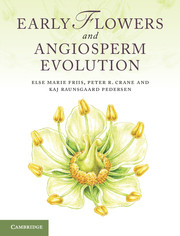Book contents
- Frontmatter
- Contents
- Preface
- 1 Introduction to angiosperms
- 2 The nature of the angiosperm fossil record
- 3 The environmental context of early angiosperm evolution
- 4 Stratigraphic framework and key areas for Cretaceous angiosperms
- 5 Angiosperms in context: extant and fossil seed plants
- 6 Origin and age of angiosperms
- 7 Phylogenetic framework and the assignment of fossils to extant groups
- 8 Fossils near the base of the angiosperm tree
- 9 Early fossil angiosperms of uncertain relationships
- 10 Early fossils of eumagnoliids
- 11 Fossils of monocots
- 12 Fossils of eudicots: early-diverging groups
- 13 Fossils of core eudicots: basal lineages
- 14 Fossils of core eudicots: rosids
- 15 Early fossils of eudicots: asterids
- 16 Patterns of structural diversification in angiosperm reproductive organs
- 17 History and evolution of pollination in angiosperms
- 18 History and evolution of dispersal in angiosperms
- 19 Vegetational context of early angiosperm diversification
- 20 The accumulation of angiosperm diversity
- References
- Index
19 - Vegetational context of early angiosperm diversification
Published online by Cambridge University Press: 07 September 2011
- Frontmatter
- Contents
- Preface
- 1 Introduction to angiosperms
- 2 The nature of the angiosperm fossil record
- 3 The environmental context of early angiosperm evolution
- 4 Stratigraphic framework and key areas for Cretaceous angiosperms
- 5 Angiosperms in context: extant and fossil seed plants
- 6 Origin and age of angiosperms
- 7 Phylogenetic framework and the assignment of fossils to extant groups
- 8 Fossils near the base of the angiosperm tree
- 9 Early fossil angiosperms of uncertain relationships
- 10 Early fossils of eumagnoliids
- 11 Fossils of monocots
- 12 Fossils of eudicots: early-diverging groups
- 13 Fossils of core eudicots: basal lineages
- 14 Fossils of core eudicots: rosids
- 15 Early fossils of eudicots: asterids
- 16 Patterns of structural diversification in angiosperm reproductive organs
- 17 History and evolution of pollination in angiosperms
- 18 History and evolution of dispersal in angiosperms
- 19 Vegetational context of early angiosperm diversification
- 20 The accumulation of angiosperm diversity
- References
- Index
Summary
Overwhelming palaeobotanical evidence from many geographical areas indicates that angiosperms first attained ecological prominence during the mid-Cretaceous and that this led ultimately to profound changes in the composition of terrestrial plant communities and ecosystems. Knowledge of how these changes were manifested in changes in ecosystem structure and function, and how this affected, and was influenced by, larger-scale changes in the global environment is still at an early stage. A major difficulty is the relatively poor stratigraphic resolution for many Cretaceous terrestrial deposits as well as difficulties of correlating floras from different environmental settings, different latitudes and different continents. An exhaustive treatment of these issues is beyond the scope of this book, but here we provide an overview of vegetational change through the Cretaceous to place the evolutionary changes discussed in previous chapters in a broader context.
Transition to angiosperm-dominated vegetation
The transition to angiosperm-dominated vegetation did not occur simultaneously or uniformly in all parts of the world, and our understanding of how this great transition unfolded geographically is still rudimentary. Nevertheless it is possible to distinguish some broad patterns, and estimates of the timing and magnitude of angiosperm diversification through the Cretaceous have been made at both regional (e.g. Samylina, 1976; Lupia et al., 1999; Cantrill and Poole, 2005) and global scales (e.g. Niklas et al., 1980; Crane, 1987; Crane and Lidgard, 1990; Lidgard and Crane, 1990). Data on the transition to angiosperm-dominated vegetation are most complete from middle- and high-palaeolatitude regions of Laurasia.
- Type
- Chapter
- Information
- Early Flowers and Angiosperm Evolution , pp. 461 - 474Publisher: Cambridge University PressPrint publication year: 2011

